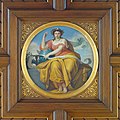Auditorium of the Old University (Heidelberg)
The auditorium of the Old University in Heidelberg is its central space.
Building history
The Old University building was built in a 23-year construction period from 1712 to 1735 according to the construction plans of the architect Johann Adam Breunig . The central hall of the Old University is the auditorium.
It was originally built in the Baroque style and had a stucco ceiling. Hierarchically defined seating plans for individuals and groups of people have been handed down for the auditorium. The front area with its characteristic round benches, in which the lectern is located, was intended especially for the representatives of the four faculties and the Senate.
For the 500th anniversary of Heidelberg University in 1886, the auditorium was redesigned in the neo-renaissance style according to plans by the architect Josef Durm . A gallery installed in the entrance area as well as on the two long sides divides the room into two levels. The history of the University of Heidelberg is represented in numerous details in the hall with its oak-colored wooden paneling.
use
The auditorium was originally used as a meeting room and lecture hall. Nowadays the auditorium is the central representation room of the University of Heidelberg. It is mainly used for academic celebrations such as the faculties or for the traditional annual celebration of the university at the beginning of each winter semester. The auditorium is also a place for public concerts, lectures and similar celebrations.
Design of the interior
Face
The front wall of the auditorium is strictly symmetrical and equipped with architectural elements of a triumphal arch. It is considered the highlight of the room composition of the auditorium. In the center of the triumphal arch element is the painting "Foundation of Heidelberg University" by the history painter Ferdinand Keller (1842 - 1922). The painting allegorically stages the founding act and the history of the university. It shows how Pallas Athene, the patron goddess of wisdom and the arts, enters the city of Heidelberg in an antique chariot - led by the goddess of victory Nike. Selected personalities from Heidelberg's university and intellectual history from the 14th to the 19th century appear in their wake, the numerical focus being on scholars from the time of humanism and the Reformation. Part of the Heidelberg Castle, the electoral residence, and personifications of the Neckar and the city are also shown in the picture. Two female robe figures are placed on the left and right of the painting, provided with the attributes trumpet (to personify fame) and wreath and torch (to personify science). These two bronze statues were made by the artist Adolf Heer (1849 - 1898). In the lower area there are also three portraits of the rulers: A bust created by the sculptor Karl Friedrich Moest showing the rector Grand Duke Friedrich I of Baden (1826-1907), who was rector in 1886 , is framed by two portrait paintings by the artist Ernst Schurth (1848-1940). On the right you can see the founder of the university, Elector Ruprecht I (1309-1390), and on the left, Grand Duke Karl Friedrich von Baden (1728-1811), the re-founder of the university at the beginning of the 19th century.
ceiling
The decorative elements of the wooden ceiling include four round pictures, which come from the artist Rudolf Gleichauf (1826 - 1896) and depict the faculties of Heidelberg University at that time in allegorical coding: They appear as sitting female figures with characteristic attributes such as scroll and globe (for philosophy) , Snake and bowl (for medicine), sword, law book and document (for jurisprudence) as well as the Bible and table of laws with the ten commandments (for theology).
Long sides
Along the two long sides as well as the entrance side of the auditorium, 37 names of famous Heidelberg scientists are listed, which are placed in two rows - in the upper friezes and on boards on the gallery railing. The spectrum ranges from Marsilius von Inghen , the founding rector from 1386, to professors from the 19th century such as the chemist Robert Bunsen or the physiologist and physicist Hermann von Helmholtz . On the right balcony of the gallery is the festival banner, which was made for the 500th anniversary of Ruperto Carola. An allegory of the sciences can be seen in the center of the banner. On the back there is the dedication: "GESTIFTET / VON / WOMEN AND DAUGHTERS / THE / ACADEMIC TEACHER / 1886".
Entrance area
The Grand Duke of Baden is honored in an inscription in the upper frieze on the entrance side of the auditorium. A congratulation plaque from the University of Freiburg from 1886 hangs in the archway of the entrance area .
literature
- The old auditorium of Heidelberg University . On behalf of the rector, ed. by Heike Hawicks and Ingo Runde. Heidelberg 2016. doi: 10.17885 / heiup.122.149
- Sabine Bock: The artistic design of the Heidelberg university anniversaries . Heidelberg 1993
- Dagmar Drüll: Heidelberger Gelehrtenlexikon 1386–1651 . Berlin / Heidelberg 2002
- Dagmar Drüll: Heidelberger Gelehrtenlexikon 1652–1802 . Berlin / Heidelberg 1991
- Dagmar Drüll: Heidelberger Gelehrtenlexikon 1803-1932 . Berlin / Heidelberg 1986, 2nd edition 2018
- Sabine Juschka: The Old University . In: Semper Apertus. Six hundred years of Ruprecht-Karls-Universität Heidelberg 1386–1986 .
- Peter Anselm Riedl (Ed.): Volume V: The buildings of the University of Heidelberg . Berlin / Heidelberg 1985, pp. 48-72.
Coordinates: 49 ° 24 ′ 40.5 " N , 8 ° 42 ′ 22.7" E







